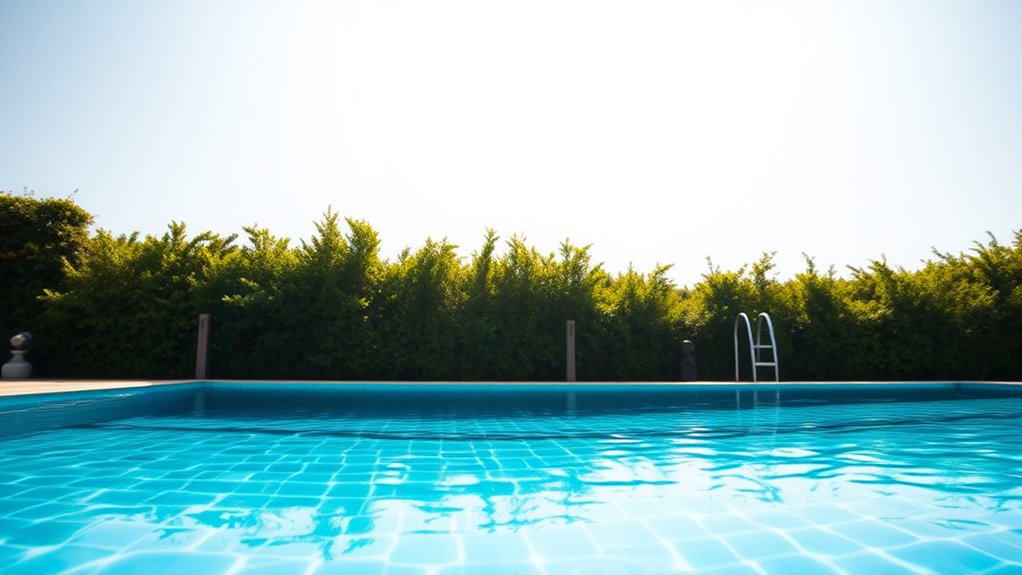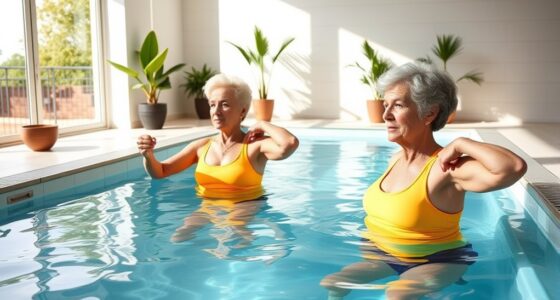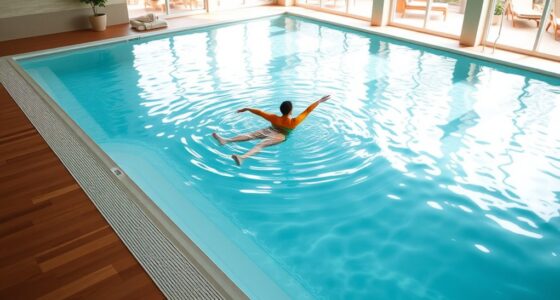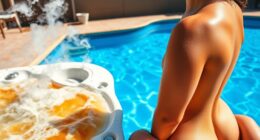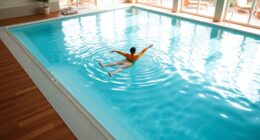Your endless pool can last between 15 to 25 years or more with proper installation, regular maintenance, and good care. Factors like the quality of materials, environmental conditions, and routine upkeep influence its lifespan. Using durable materials, protecting it from harsh sunlight, and scheduling inspections help extend its life. If you want to discover how to maximize your pool’s longevity and spot signs of aging, keep exploring these crucial tips.
Key Takeaways
- The average lifespan of an endless pool is typically 15-25 years with proper maintenance.
- High-quality materials and good installation can extend the pool’s durability beyond the average lifespan.
- Regular cleaning, chemical balancing, and equipment checks help prevent early deterioration and costly repairs.
- Environmental factors like harsh weather, UV exposure, and temperature fluctuations can shorten the pool’s lifespan.
- Components such as pumps and filters may need replacement around 10-15 years, depending on usage and upkeep.
Understanding the Average Lifespan of an Endless Pool
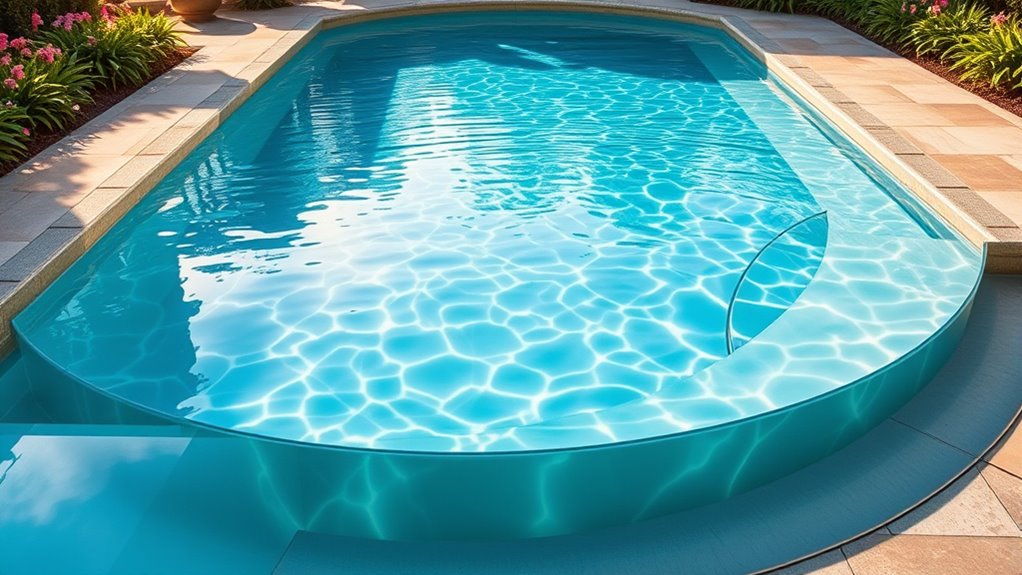
Understanding the average lifespan of an Endless Pool is essential for planning your investment and maintenance. Typically, these pools last between 15 and 25 years, depending on usage and care. High-quality materials and proper installation can extend this lifespan, making your pool a long-term investment. Regular maintenance, such as cleaning filters and checking structural components, helps prevent early deterioration. The lifespan also varies based on the environment; pools exposed to harsh weather or extreme temperatures may wear out sooner. Keep in mind that components like pumps, filters, and heaters often need replacement around the 10-15 year mark. Knowing this helps you budget for repairs and upgrades, ensuring your Endless Pool remains a reliable part of your home for years to come. Proper storage and maintenance can further extend its longevity and performance.
Key Factors That Affect Pool Durability
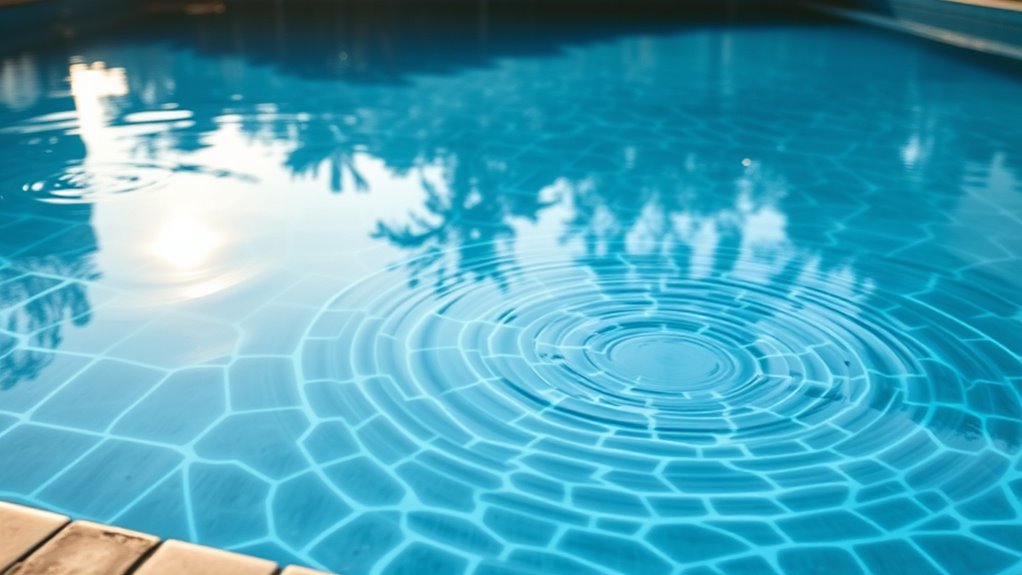
Several key factors determine how long your Endless Pool will last, and paying attention to these can help you maximize its durability. First, proper maintenance plays a vital role—regular cleaning, chemical balancing, and filter checks prevent buildup and corrosion. Environmental conditions also matter; exposure to harsh weather or direct sunlight can accelerate wear, so using a cover and installing in a sheltered area helps protect your pool. Water chemistry stability prevents damage caused by pH imbalances and algae growth. Additionally, your pool’s usage frequency impacts its lifespan; excessive use without proper upkeep can lead to faster deterioration. Regularly inspecting your pool’s components and ensuring proper pool equipment maintenance can significantly extend its lifespan. Finally, timely repairs of minor issues prevent them from escalating into costly damage. By focusing on these factors, you can considerably extend your Endless Pool’s lifespan and enjoy it for years to come.
Material Quality and Construction Standards

The durability of your Endless Pool heavily depends on the quality of materials used and how well it’s constructed. High-grade, corrosion-resistant materials like marine-grade stainless steel, durable plastics, and reinforced acrylic ensure longevity, especially in wet environments. Construction standards matter too; a well-built pool features solid welds, strong seals, and precise assembly, preventing leaks and structural issues over time. Reputable manufacturers adhere to strict quality controls, incorporating industry best practices. Cheaper materials or shoddy craftsmanship may save money upfront but often lead to faster wear, cracks, or leaks. Investing in a pool built with top-tier materials and strict standards guarantees better resilience against corrosion, UV damage, and daily wear, extending its lifespan and maintaining performance for years to come. Additionally, regular maintenance and inspections can significantly extend the lifespan of your Endless Pool by identifying issues early before they cause major damage.
The Role of Proper Maintenance and Care

Keeping your pool in top shape relies on a consistent cleaning routine, so you prevent debris buildup and algae growth. You also need to maintain proper water chemistry to protect your equipment and ensure safe swimming conditions. Regularly checking your equipment helps catch issues early and keeps your pool running smoothly for years to come. Incorporating automated insights can assist in monitoring water quality and equipment performance for optimal maintenance.
Regular Cleaning Routine
How often you clean your endless pool directly impacts its lifespan and performance. Regular cleaning prevents dirt, debris, and algae buildup that can strain the system and cause premature wear. You should rinse the pool’s surface and walls weekly to remove surface contaminants. Using a soft brush or cloth, scrub any spots of algae or grime, especially around the waterline. Don’t forget to clean the filter as recommended by the manufacturer—clogged filters reduce circulation and strain the pump. Maintaining a consistent cleaning routine keeps your pool clear and minimizes the risk of damage from dirt or algae. Proper care diminishes the likelihood of costly repairs down the line and ensures your pool remains in top condition for years to come. Additionally, understanding the importance of regular maintenance can help you identify potential issues early and extend the lifespan of your endless pool.
Proper Water Chemistry
Maintaining proper water chemistry is essential to guarantee your endless pool stays clean, safe, and functioning efficiently. When your water’s pH, alkalinity, and sanitizer levels are balanced, you prevent algae growth, cloudy water, and equipment damage. Regularly test your water with reliable test kits or digital meters, and adjust chemicals accordingly. Keep pH between 7.2 and 7.6, and ensure sanitizer levels—like chlorine or bromine—are within the recommended range. Proper water chemistry also helps protect your skin and eyes from irritation. Consistent maintenance prevents costly repairs and extends your pool’s lifespan. Remember, neglecting water chemistry can lead to corrosion, scaling, and bacteria buildup, all of which compromise the integrity and safety of your endless pool. Staying vigilant and maintaining optimal water conditions promotes longevity and your pool will reward you with years of enjoyment.
Scheduled Equipment Checks
Regularly scheduled equipment checks are essential to ensuring your endless pool operates smoothly and safely. By inspecting your pump, filter, heater, and jets regularly, you catch potential issues before they become costly repairs or safety hazards. Look for leaks, unusual noises, or signs of corrosion, and replace worn parts promptly. Keep an eye on the filter’s condition, cleaning or replacing it as needed to maintain water quality and circulation. Test the equipment’s performance periodically, ensuring the heater heats properly and the pump maintains consistent flow. Proper maintenance not only extends your pool’s lifespan but also enhances your swimming experience. Set a routine schedule, and don’t skip these checks—consistent care is key to maximizing your pool’s longevity and safety. Additionally, understanding the performance metrics of your equipment can help you identify when it’s time for upgrades or repairs, ensuring optimal operation.
Environmental Influences and Placement Considerations
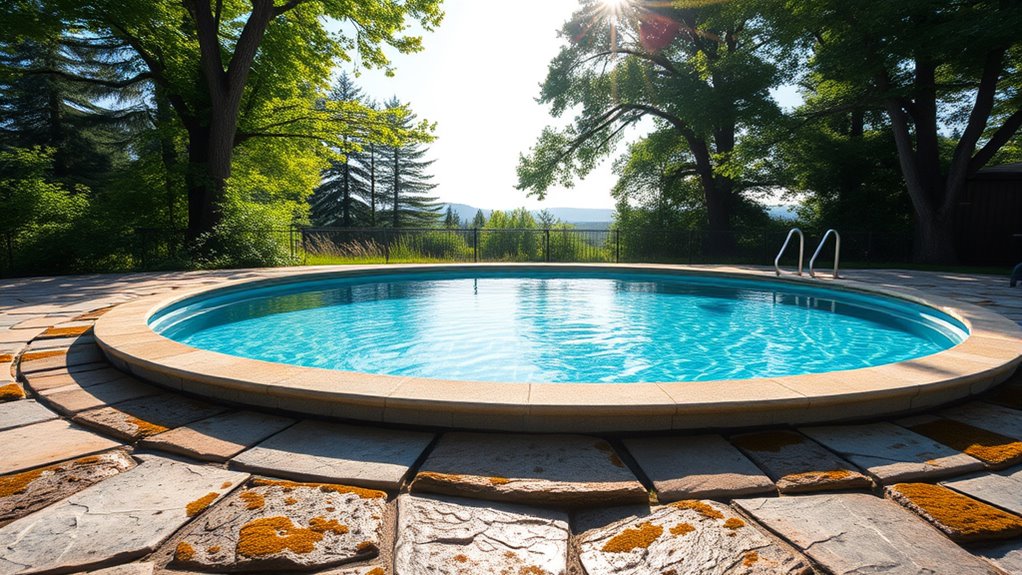
You need to take into account your climate and temperature, as extreme conditions can affect your pool’s longevity. Proper site preparation ensures stability and protection from the elements, reducing wear over time. Also, think about sunlight and shade, since too much sun can cause algae growth and damage, while shade helps extend the pool’s lifespan. Regular maintenance and home energy efficiency improvements can further protect your investment from environmental stresses.
Climate and Temperature Effects
Climate and temperature play a crucial role in determining the lifespan of an endless pool, as environmental conditions can impact its longevity and performance. Extreme weather, temperature fluctuations, and sunlight exposure can accelerate wear and tear. Cold climates may cause freezing issues if not properly insulated, while excessive heat can degrade parts faster. To understand these effects better, consider this table:
| Climate Type | Potential Impact | Recommended Action |
|---|---|---|
| Cold | Freezing, cracking, insulation needs | Use heaters and insulation |
| Hot | Material degradation, algae growth | Shade and chemical balance |
| Moderate | Minimal impact | Regular maintenance |
Proper placement and climate awareness help extend your pool’s lifespan and maintain ideal performance. Additionally, selecting appropriate materials during installation can further mitigate environmental effects.
Proper Site Preparation
Choosing the right site for your endless pool is essential to guarantee ideal performance and longevity. You want a flat, stable surface free of debris and sharp objects that could damage the pool or its components. Guarantee proper drainage around the area to prevent water pooling, which can cause structural issues and mold growth. Avoid placing your pool near trees or plants that shed leaves, as these can clog filters and require frequent cleaning. Keep the site away from strong winds or areas prone to flooding, which could introduce environmental stress or water damage. Additionally, consider accessibility for maintenance and ease of use. Proper site preparation creates a stable foundation, minimizes environmental risks, and helps your pool last longer, saving you time and money in the long run. Using a Pimple Patch can also be beneficial for skin health in outdoor environments, especially when exposed to sun and pollutants.
Sunlight and Shade Impact
Proper site preparation sets the foundation for your endless pool’s durability, but environmental factors like sunlight and shade also play a significant role. Excessive sun exposure can cause the pool’s surfaces and equipment to wear faster, and prolonged shade might lead to mold or algae buildup. To optimize longevity, consider the placement carefully.
- Avoid placing the pool where it receives constant direct sunlight, which accelerates UV damage.
- Use shade structures or trees to protect the pool during peak sunlight hours.
- Ensure good airflow to reduce humidity and prevent mold growth.
- Position the pool away from overhanging branches that can drop debris.
- Regularly check and adjust shading to prevent sun damage and algae growth, extending your pool’s lifespan.
Signs Your Pool May Be Approaching the End of Its Life
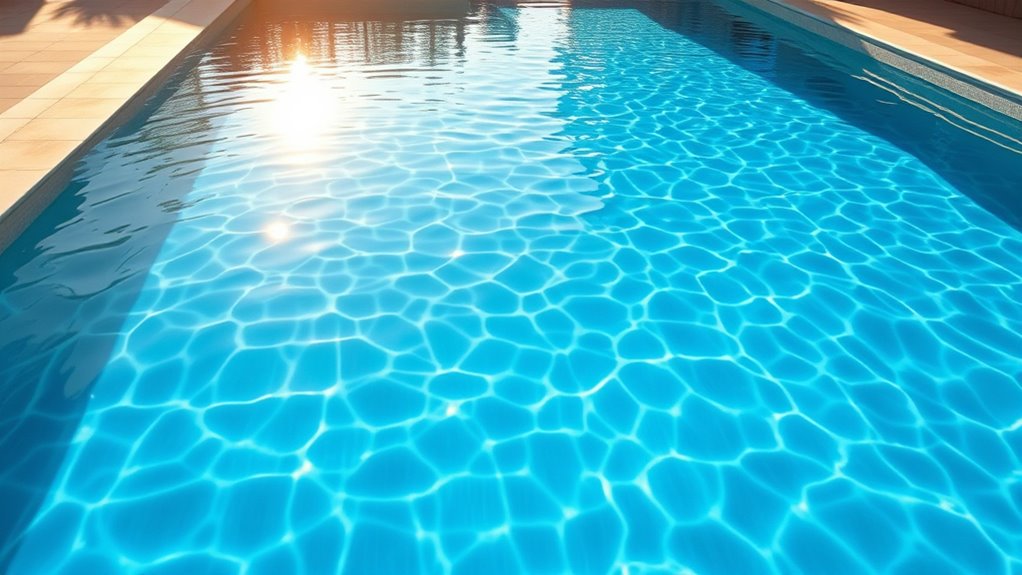
Over time, you might notice your pool requires more frequent repairs or ongoing issues that just won’t go away. Cracks in the shell or tiles can be signs the structure is weakening. If your water chemistry becomes difficult to balance despite regular maintenance, it could indicate deterioration of the pool’s materials. Persistent leaks or a sudden drop in water levels suggest issues with the liner or plumbing. Fading or peeling surfaces may point to aging components. Additionally, if the equipment becomes increasingly unreliable or noisy, it’s a sign that parts are wearing out. These signs indicate your pool’s lifespan is nearing its end, and you should start planning for repairs or replacements to ensure safety and continued enjoyment.
Tips for Extending the Longevity of Your Pool

Maintaining your pool regularly can considerably extend its lifespan and keep it functioning smoothly for years to come. Consistent care prevents damage and ensures peak performance. Start by cleaning the filters and skimming debris daily to prevent buildup. Test and balance the chemical levels weekly to avoid corrosion and algae growth. Inspect your equipment regularly for signs of wear, and address small issues before they become major repairs. Cover your pool when not in use to protect it from dirt and UV damage. Finally, schedule professional inspections annually to catch potential problems early.
- Clean filters and skimmers weekly
- Balance chemicals consistently
- Inspect equipment for wear
- Use a pool cover when idle
- Schedule annual professional checkups
When to Consider Repairs, Upgrades, or Replacements

Knowing when to repair, upgrade, or replace parts of your pool is essential for maintaining its lifespan and performance. If you notice persistent issues like frequent leaks, declining water quality, or equipment failures, it’s time to contemplate repairs. Upgrades become relevant when your pool’s technology or features become outdated, or if new options can improve efficiency and enjoyment. Replacements are necessary when repairs become cost-prohibitive or the pool’s structure shows significant wear, such as cracked panels or a compromised liner. Regular inspections help identify these signs early, preventing more extensive damage. Addressing problems promptly ensures your pool remains safe, efficient, and enjoyable for years to come. Don’t wait until issues disrupt your experience—stay proactive with maintenance and timely updates.
Frequently Asked Questions
How Does Water Chemistry Impact Pool Lifespan?
Water chemistry directly affects your pool’s lifespan by preventing corrosion, algae growth, and scale buildup. When you maintain proper pH, alkalinity, and sanitizer levels, you protect your pool’s surfaces, equipment, and plumbing. Poor water chemistry causes corrosion and staining, which can lead to costly repairs and shorten its life. Regular testing and balancing are essential to keep your pool in top condition and extend its overall durability.
Can Remodeling Extend My Pool’s Durability?
Think of your pool as a garden that needs regular tending; remodeling acts like nourishing the soil. It can definitely extend your pool’s durability by updating worn-out parts, improving structural integrity, and addressing early signs of wear. When you invest in remodeling, you’re planting seeds for longevity, ensuring your pool remains a vibrant, reliable oasis for years to come. Proper updates keep your pool resilient against the elements and time.
Are There Specific Climates That Shorten Pool Lifespan?
Yes, certain climates can shorten your pool’s lifespan. If you live in areas with harsh winters, freezing temperatures can cause ice damage and cracks if your pool isn’t properly winterized. Hot, humid climates may promote algae growth and corrosion, leading to faster wear. To extend your pool’s life, invest in good insulation, regular maintenance, and protective covers, especially if you face extreme weather conditions.
How Do User Habits Influence Pool Longevity?
Your habits greatly impact your pool’s lifespan. Regularly cleaning and maintaining your pool prevents buildup of dirt, algae, and corrosion, which can damage the surface and equipment. Using chemicals properly and avoiding overuse helps prevent deterioration. Covering your pool when not in use reduces debris and exposure to the elements. By staying attentive to maintenance and usage, you extend your pool’s longevity and ensure it remains in great condition for years.
What Warranties Are Typically Available for Endless Pools?
Most endless pools come with a standard warranty of 1 to 5 years, covering structural components and equipment. For example, if your pool’s pump fails within the first two years, the warranty often covers replacement costs. You should also consider extended warranties for added peace of mind, especially on electronics and major parts. Always read the warranty details carefully to understand what’s covered and for how long.
Conclusion
Think of your endless pool like a trusted old friend—you’ll get the most out of it with proper care. With good maintenance, quality materials, and mindful placement, your pool can last well over a decade. Just like a well-loved book, it’s worth investing time to keep it in great shape. When you notice signs of wear, address them early—so your pool continues to be a invigorating oasis for years to come.
